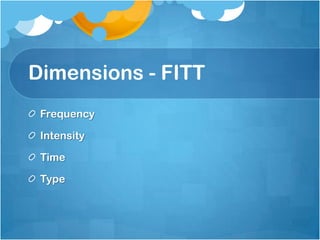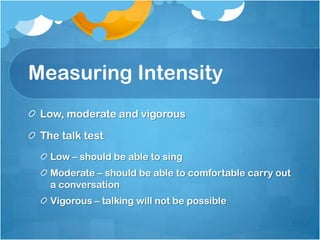Fitt and halo
- 2. Domains â Types of PA HALO Household/gardening Active Transport Leisure Occupational
- 4. Intensity The level of intensity has the most impact on the long term health and fitness benefits individuals obtain from physical activity The intensity of the activity impacts the frequency, time and type of activity you can perform
- 5. Measuring Intensity Low, moderate and vigorous The talk test Low â should be able to sing Moderate â should be able to comfortable carry out a conversation Vigorous â talking will not be possible
- 6. RPE â Rate of Perceived Exertion
- 7. Target HR - % Max HR Low intensity â less than 50% of MAX HR Moderate intensity â 50% - 70% of MAX HR Vigorous intensity â more than 70% of MAX HR Max HR = (220 â age) OR 208 â (0.7 x age)
- 8. Metabolic Equivalent (MET) level A more exact measure of intensity is the MET. ONE MET equals the energy (oxygen) used by the body as you sit quietly. The harder your body works, the higher the MET level. Low = less than 3 MET level Moderate = 3 â 6 MET level Vigorous = More than 6 MET level







